Rudolf Hoess and the Hungarian
Jews
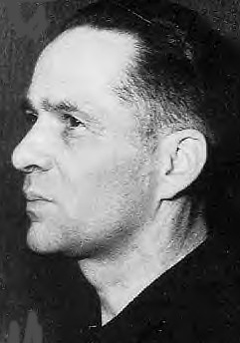
Rudolf Hoess, Commandant
of Auschwitz
The first Commandant of Auschwitz was
Rudolf Höss, aka Rudolf Hoess, who was given this assignment
on May 1, 1940.
Höss was relieved of his duties
as the Commandant of the Auschwitz complex at the end of November
1943 and promoted to a position in the Economic Administration
Head Office (WHVA) in Oranienburg. His wife and five children
continued to live in the Commandant's house, located outside
the main camp, which is shown in the photo below.
 House where Commandant
Rudolf Hoess once lived at the main camp
House where Commandant
Rudolf Hoess once lived at the main camp
On December 1, 1943, Höss was replaced
by Arthur
Liebehenschel, who became the new Commandant of the Auschwitz
main camp only. When Höss was the Commandant, he was in
charge of all three of the Auschwitz camps.
As the new Commandant of the Auschwitz
main camp, Liebehenschel was much more lenient than Höss;
he made many changes that improved the living conditions in the
camp.
Höss wrote in his autobiography
that he was given the choice of becoming the new commandant of
the Sachsenhausen
concentration camp or taking a senior position in the Economic
Administration Head Office in Oranienburg, which was Liebehenschel's
previous job. Höss chose the job in the Head Office in Oranienburg;
this was the office which inspected all the concentration camps
and gave permission for punishment of a prisoner after a report
was submitted by the camp commandant.
Although Höss changed his testimony
at his own trial in 1947 in Poland and stated that a total of
around one million persons had been killed at Auschwitz, he had
previously testified on April 15, 1946, as a defense witness
for Ernst Kaltenbrunner at the Nuremberg IMT, that the numbers
were far higher. In a signed affidavit which was entered into
the proceedings of the Nuremberg IMT, Hoess confessed that 2.5
million persons had been exterminated, and 500,000 more had died
from disease and starvation during the time that he was the Commandant
between June 14, 1940 and December 1, 1943.
On May 8, 1944, Höss was brought
back to Auschwitz to be the Commander of the SS men at Auschwitz
and to supervise the gassing of the Hungarian Jews. According
to Laurence Rees, in his book "Auschwitz, a New History,"
Höss was also given authority over the Commandants of the
Auschwitz II and Auschwitz III camps when he came back in May
1944.
Arthur Liebehenschel was sent to the
Majdanek death camp
to be the new Commandant. The gassing of most of the Hungarian
Jews did not take place until after Höss returned to Auschwitz
and took charge of the Hungarian Action.
The first thing that Höss did, the
next day after he arrived, was to order the construction of a
branch railway line into the Birkenau camp so that the Hungarian
Jews could be brought to within a few yards of the gas chambers
in Krema II and Krema III. He also ordered that the crematory
ovens in Krema V, which had broken down after two months, should
be repaired and that five new burning pits should be dug.
Höss wrote the following in his
autobiography, with regard to the deportation of the Hungarian
Jews:
On Pohl's orders I made three visits
to Budapest in order to obtain an estimate of the number of able-bodied
Jews that might be expected. [...] Eichmann was completely obsessed
with his mission and also convinced that this extermination action
was necessary in order to preserve the German people in the future
from the destructive intentions of the Jews. Eichmann was also
a determined opponent of the idea of selecting from the transports
Jews who were fit for work. He regarded it as a constant danger
to his scheme for a "final solution'' because of the possibility
of mass escapes or some other event occurring which would enable
the Jews to survive.
Eichmann had apparently had a complete
change of heart since his days of traveling to Palestine and
studying Hebrew so that he could implement his plan to transport
the Jews to their own Jewish state in Palestine.
In spite of Eichmann's disapproval, "tens
of thousands of Jews were removed from Auschwitz for the armaments
project," according to what Höss wrote in his autobiography.
Hoess complained about the selection
process at Auschwitz, during which Jews who were not strong enough
for work, in his opinion, were saved from the gas chamber. He
wrote the following in his autobiography:
If Auschwitz had followed my constantly
repeated advice, and had only selected the most healthy and vigorous
Jews, then the camp would have produced a really useful labor
force and one that would have lasted, although it is true that
it would have been numerically smaller.
According to Höss:
The sick cluttered up the camps, depriving
the able-bodied of food and living space and doing no work, and
in fact their presence made many of those who could work incapable
of it.
The first mass transport of over 6,000
Hungarian Jews was sent to Auschwitz in two trains on May 15,
1944; the trains arrived on May 16, 1944. According to Danuta
Czech, who wrote several books about the history of Auschwitz,
all the Jews on this transport were immediately gassed without
going through a selection.
The photo below shows a group of Hungarian
Jews who arrived on May 26, 1944. They are waiting in front of
one of the clothing warehouses at Birkenau, directly across from
the Sauna building where incoming prisoners were given a shower.
The Krema IV gas chamber, which was disguised as a shower room,
was near the Sauna.
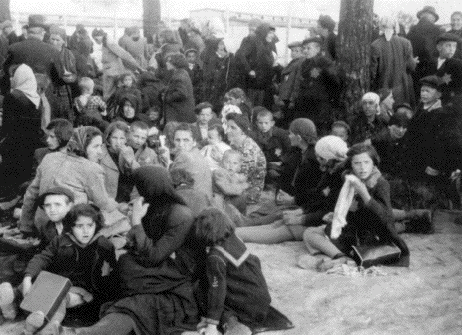 Hungarian children
waiting to be gassed
Hungarian children
waiting to be gassed
In the photo below, an SS man is directing
a column of men to the left or the right. The two women in the
foreground have just been sent in the direction of Krema III,
only a few yards from the train tracks, where there was an underground
gas chamber and crematory ovens. The gas chambers in Krema IV
and Krema V, which were disguised as shower rooms, were on the
northern side of the camp in the same direction. The Central Sauna where incoming prisoners were
given a shower and registered was across the road from Krema
IV. The prisoners did not know until the very last second whether
they had entered a fake shower room that was really a gas chamber,
or a real shower room.
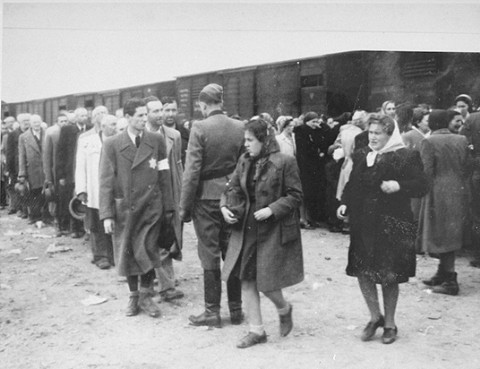 Hungarian Jews undergoing
selection in Auschwitz-Birkenau
Hungarian Jews undergoing
selection in Auschwitz-Birkenau
Höss was arrested by the British
Military Police near Flensburg in Schleswig-Holstein on March
11, 1946. In the photo below, he is shown while in custody.
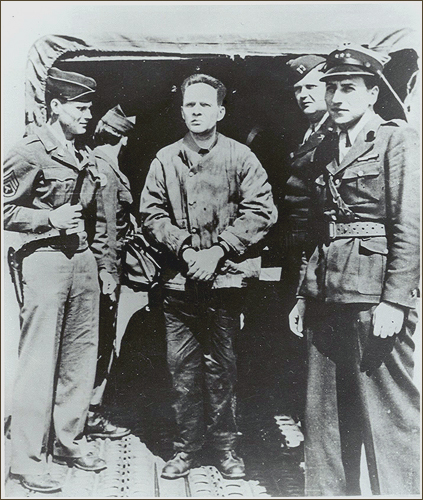 Rudolf Hoess after
his capture by the British
Rudolf Hoess after
his capture by the British
On April 5, 1945, Höss signed a
sworn deposition, written in English, which was introduced as
evidence at the Nuremberg IMT; he admitted to killing 2.5 million
Jews in the gas chambers at Auschwitz-Birkenau, even before the
deportation of the Hungarian Jews which added another 400,000
to the total.
The following quote is from his sworn
affidavit entered into the proceedings of the Nuremberg IMT:
I have been constantly associated
with the administration of concentration camps since 1934, serving
at Dachau until 1938; then as Adjutant in Sachsenhausen from
1938 - 5/1/1940, when I was appointed Kommandant of Auschwitz.
I commanded Auschwitz until 12/1/1943 and estimate that at least
2.5 million victims were executed and exterminated there by gassing
and burning, and at least another half million succumbed to starvation
and disease making a total dead of about 3 million. This figure
represents about 70-80% of all persons sent to Auschwitz as prisoners,
the remainder having been selected and used for slave labor in
the concentration camp industries; included among the executed
and burned were approximately 20,000 Russian prisoners of war
(previously screened out of prisoner-of-war cages by the Gestapo)
who were delivered at Auschwitz in Wehrmacht transports operated
by regular Wehrmacht officers and men. The remainder of the total
number of victims included about 100,000 German Jews, and great
numbers of citizens, mostly Jewish, from Holland, France, Belgium,
Poland, Hungary, Czechoslovakia, Greece, or other countries.
We executed about 400,000 Hungarian Jews alone at Auschwitz in
the summer of 1944.
Notice that Hoess includes "citizens"
of Hungary in the prisoners who were gassed while he "commanded
Auschwitz until 12/1/1943." The first two transports of
Hungarian Jews did not arrive at Auschwitz-Birkenau until May
2, 1944. Nevertheless, when Hoess was asked, during cross examination
by American prosecutor Col. Harlan Amen, if his affidavit was
correct with regard to the statement above, he answered "Es
stimmt." The English equivalent would be "That's correct."
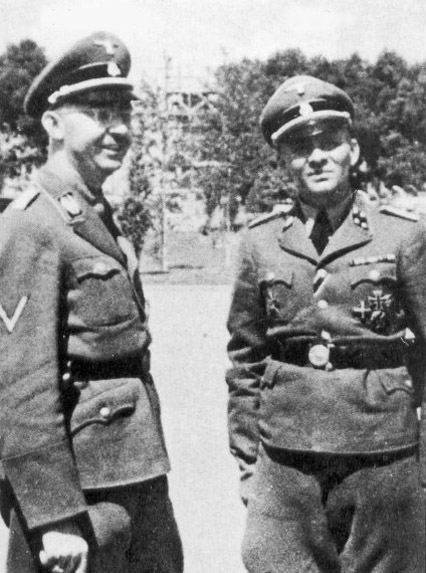 Reichsführer-SS
Heinrich Himmler on the left, Rudolf Hoess on the right
Reichsführer-SS
Heinrich Himmler on the left, Rudolf Hoess on the right
The following is a quote from the Judgment
handed down at the Nuremberg IMT:
German missions were sent to such
satellite countries as Hungary and Bulgaria, to arrange for the
shipment of Jews to extermination camps and it is known that
by the end of 1944, 400,000 Jews from Hungary had been murdered
at Auschwitz. Evidence has also been given of the evacuation
of 110,000 Jews from part of Romania for "liquidation."
Adolf Eichmann, who had been put in charge of this programme
by Hitler, has estimated that the policy pursued resulted in
the killing of 6,000,000 Jews, of which 4,000,000 were killed
in the extermination institutions.
Adolf Eichmann did not testify at the
Nuremberg IMT. The Judgment at Nuremberg, with regard to the
killing of 6 million Jews in the Holocaust, was mostly based
on hearsay testimony given in an affidavit, dated 26 November
1945, by former SS officer Wilhelm Höttl. Höttl stated
that Adolf Eichmann, the head of the Jewish section of the Reich
Security Main Office (RSHA), had told him in August 1944 that
four million Jews had been killed in the extermination camps,
and another two million had been killed by the Einsatzgruppen
on the Eastern front. After the German surrender in May 1945,
Höttl had been recruited to work with American intelligence.
Rudolf Höss
also mentioned in his sworn affidavit, entered into the proceedings
at Nuremberg, that he had personally received an order from Reichsführer-SS
Heinrich Himmler, the SS general in charge of all the concentration
camps, to exterminate the Jews who were deported to Auschwitz.
Höss wrote in his autobiography
that Reichsführer-SS Heinrich Himmler ordered the extermination
of all the Jews in the summer of 1941, six months before the
Final Solution was planned at the Wannsee Conference on January
20, 1942.
The following quote is from the autobiography
of Höss:
The sub-section (of RSHA) concerned
with the Jews, controlled by Eichmann and Gunther, had no doubts
about its objective. In accordance with the orders given by the
Reichsführer SS in the summer of 1941, all Jews were to
be exterminated. The Reich Security Head Office raised the strongest
objections when the Reichsführer SS, on (Oswald) Pohl's
suggestion, directed that the able-bodied Jews were to be sorted
out from the rest.
In an appendix to his autobiography,
written in January and February 1947 while he was in prison in
Poland, there is a statement made by Höss at a later date
and typewritten by someone else. The following is a quote from
a typewritten statement taken from Höss:
In the summer of 1941, I cannot remember
the exact date, I was suddenly summoned to the Reichsführer
SS, directly by his adjutant's office. Contrary to his usual
custom, Himmler received me without his adjutant being present
and said in effect:
"The Führer has ordered
that the Jewish question be solved once and for all and that
we, the SS, are to implement that order. [...] I have now decided
to entrust this task to you. [...] You will learn further details
from Sturmbannführer Eichmann of the Reich Security Head
Office who will call on you in the immediate future."
[...]
"The Jews are the sworn enemies
of the German people and must be eradicated. Every Jew that we
can lay our hands on is to be destroyed now during the war, without
exception. If we cannot now obliterate the biological basis of
Jewry, the Jews will one day destroy the German people."
In the typewritten statement, Höss
went on to say that in the autumn of 1941, a secret order was
given to transfer Russian political Commissars in the POW camps
to the nearest concentration camp for liquidation. These prisoners
were shot in the gravel pit near the clothing warehouses or at
the black wall in the courtyard of Block 11 at the main Auschwitz
camp.
Höss wrote the following regarding
the first gassing at Auschwitz in September 1941:
When I was absent on duty, my representative,
Hauptsturmführer Fritsch, on his own initiative, used gas
for killing these Russian prisoners of war.
This was the first time that Zyklon-B
was ever used by the Nazis for homicidal gassing.
The Auschwitz Museum currently maintains
that approximately 1.1 million people died at Auschwitz of all
causes, 90% of whom were Jews.
Rudolf Höss testified at his trial
in 1947 before the Supreme National Tribunal in Warsaw that Adolf
Eichmann had told him a number of times that 400,000 Hungarian
Jews were exterminated at Auschwitz. Based on the testimony of
members of the Sonderkommando who had removed the bodies from
the gas chambers at Auschwitz-Birkenau, the Tribunal found him
guilty of the murder of 300,000 non-Jews who were registered
and at least 2.5 million Jews who were brought to the camp for
immediate extermination and were never registered.
For the gassing of the Hungarian Jews
between May and July 1944, the gas chambers in Bunker 2, an old farm house near the Central
Sauna building, had to be put into operation again, since the
four large gas chambers in the crematoria at Birkenau did not
have the capacity to handle up to 12,000 victims who were gassed
each day during the height of the "Hungarian Action."
The gas chamber in Krema I was no longer in use, and Bunker 1,
another old farm house which was used for gassing in 1942, had
been torn down.
According to the testimony of Henryk
Tauber at the trial of Auschwitz Commandant Rudolf Höss
in Poland, up to 5,000 corpses could be burned each day in Krema
II and Krema III alone. As many as 3,000 corpses could be burned
each day in Krema IV and Krema V. The old burning pits were re-excavated
and five new burning pits, which were dug near Krema V, were
used to dispose of the remaining 4,000 corpses produced by the
gas chambers each day during the height of the deportation of
the Hungarian Jews. Tauber was a member of the Sonderkommando
unit which removed the bodies from the gas chambers and put them
into the ovens. This information comes from a book entitled "Auschwitz
Nazi Death Camp," published by the Auschwitz Museum in 1996.
The following information is also included
in the book "Auschwitz Nazi Death Camp":
In the end, according to a letter
from the Zentralbauletung der Waffen-SS und Polizei Auschwitz
to Administrative Groups C of SS-WVHA of June 28, 1943, it was
found that each crematorium had the following capacities in 24
hours: Crematorium I - 340 corpses, Crematorium II - 1440 corpses,
Crematorium III - 1440 corpses, Crematorium IV - 768 corpses,
Crematorium V - 768 corpses.
Altogether, the crematoria could burn
a total of 4,756 corpses a day.
The Birkenau camp was built on marshy
ground but prisoners in a punishment Kommando had been forced
to dig a deep drainage ditch, called the Königsgraben, at
the western end of the camp near where the burning pits were
located.
According to the book "Nazi Death
Camp," around 100 members of the Sonderkommando who worked
in the gas chamber buildings at Birkenau were among the 60,000
prisoners who were marched out of the camp, under SS escort,
on January 18, 1945 when the three Auschwitz camps were abandoned.
The Nazis didn't anticipate that some of these Sonderkommando
workers would survive and testify against them in war crimes
trials after the war. Besides Tauber, there were two others,
Szlama Dragon and Alter Feinsilber, aka Stanislaw Jankowski,
who also testified about the gassing of the Jews at the trial
of Rudolf Höss in Poland after the war. Three other members
of the Sonderkommando, who were murdered after a few months on
the job, had managed to hide their diaries, containing accounts
of the gassing of prisoners at Birkenau, in containers which
they buried in the ground to be discovered later by survivors.
This page was last updated on January
11, 2010
|